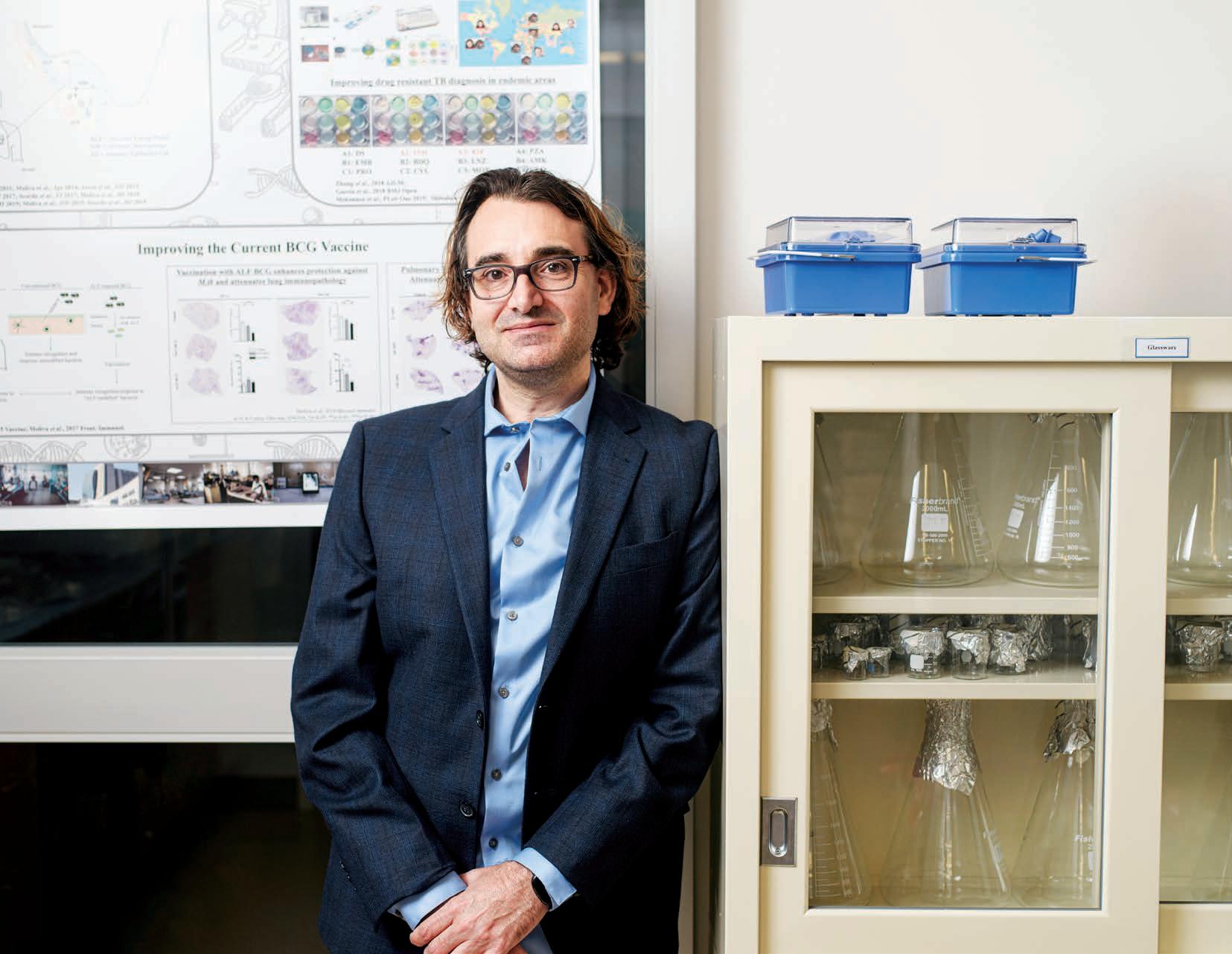
19 minute read
2020: A YEAR LIKE NO OTHER
SCIENCE IS THE HERO
ACCOUNTS OF LIFE AND SCIENCE DURING COVID-19
IN 2020, words that once graced the pages of science fiction novels became reality. In what felt like one day, businesses, restaurants, schools, playgrounds — all the places we live, work and visit — simply shut down. And, while we have so many essential workers to thank for their heroic efforts to get us through the past year and a half — healthcare workers, grocery workers, truck drivers, first responders and more — researchers and scientists led the way in providing both hope and a way out of the darkness.
Scientists were on TV every night helping citizens across the globe understand terms like social/physical distancing, transmission rate, flattening the curve, herd immunity, PPE and many others. Facing the pressure to deliver a reprieve in the form of a vaccine while also educating the public and continuing research into ongoing health crises, scientists also faced the same realities and lived with the same fears as everyone else. In the following five stories, we share personal accounts from scientists who were on the front lines of COVID-19 and other disease research to learn what it was like to work through 2020.
LAUNCHING A NEW, COLLABORATIVE PROGRAM INTO COVID-19
Jordi B. Torrelles, PhD, Professor, BSL-3 Program Director
The first time I heard about the new coronavirus I was in the Democratic Republic of the Congo. It was late January 2020, and I was there with several other scientists. We were about to implement a study on developing better treatments for drug-resistant tuberculosis. We started looking at the news every day before breakfast, and we saw that the outbreak was getting larger. At that time nobody even knew how the virus was transmitted.
When I got back to the United States the last day of January, I met with some of my colleagues at Texas Biomed. We decided to create a coronavirus working group that would meet regularly and review all the research. Everybody looked at me, because I was the only one of the group who was not a virologist and decided I would be a great coordinator, because I had no conflicts of interest.
The initial team was formed by some of our Texas Biomed virology experts that could quickly jump into Coronavirus research: Drs. Jean Patterson, Luis Giavedoni, Ricardo Carrion, Jr., Luis Martinez-Sobrido, and animal model experts such as Drs. Deepak Kaushal, Joanne Turner, myself and a geneticist expert, Dr. Tim Anderson. Later this Coronavirus Working Group expanded to include more than 15 Texas Biomed scientists and growing.
Jordi B. Torrelles, PhD
We started to have very intensive weekly meetings to try and figure out the best way that Texas Biomed could assist in battling this problem. Dr. Schlesinger and Dr. Turner started fundraising to get the money needed to develop different animal models. We didn’t know anything about which animal model would be the best, but we knew these models would be needed to start developing therapies and treatments. My main job was coordinating and keeping track of everything that was going on.
The first thing we needed to do was to obtain a sample of SARS-CoV-2. We got one that was a derivative of the strain found in a patient in Washington State. We began to focus our attention on non-human primate models and decided to go with three species: baboons, rhesus macaques and marmosets.
Then we received a call from the Jackson Laboratory in Maine, asking us if we were prepared to work on the development of a new mouse model of SARS-CoV-2 infection. Of course, we said yes. We had the team in place; we had the capacity in our biosafety level (BSL)-3 labs and we had the expertise.
We knew that the mouse model would be important for evaluating potential new therapies and vaccines, and that it would be needed to decide what approaches to test in higher animal models like non-human primates. It was a race against time to develop this model quickly. Other labs were working on the same problem, using different experimental designs. But in the end, we all got the same result. Our team published two major papers on these animal models. The study on the transgenic mouse model for SARS-CoV-2 infection was published in Nature Communications in November 2020. The study on responses to infection with SARS-CoV-2 in the lungs of non-human primates was published in Nature Microbiology in January 2021. Texas Biomed was also contacted by the Bill & Melinda Gates Foundation (BMGF) to participate in the Coronavirus Immunotherapy Consortium (CoVIC), an international collaborative group evaluating monoclonal antibody (MAb) therapeutics for COVID19. Dr. Martinez-Sobrido and I were selected to co-lead a project to evaluate the efficacy of these MAbs in small rodent models. We have developed a screening platform to test the ability of the antibodies to protect against the progression of disease using our transgenic mouse models as well as golden Syrian hamster models. The ultimate goal of CoVIC is to identify the combinations of MAbs that offer the most protection. At the same time we were doing SARSCoV-2 research, we were still doing work on tuberculosis. COVID-19 is the pandemic of the moment, but tuberculosis has not gone away. It kills someone every 21 seconds. Tuberculosis gets a lot less attention, because it mostly affects middle- and low-income countries, but it’s actually a big concern along the Texas-Mexico border, where we have seen the development of drug-resistant disease.
We recognize the members of the Texas Biomed BMGF project team (Paula PinoTamayo, Jun-Gyu Park, Alison Whigham, Amberlee Hicks, Colwyn Headley, Juan I. Garcia, Andreu Garcia-Vilanova, Anna Allue Guardia, Oscar Rodriguez, Billie Maingot, Jennifer Delgado, Angélica Olmo-Fontánez and Chengjin Ye) for their dedication to this important project.
COVID-19 AND THE IMPACT ON OTHER PANDEMIC RESEARCH
Juan Ignacio Garcia, PhD,
Postdoctoral Researcher
While many people in our group were working on COVID-19, I went to Mozambique to continue our tuberculosis project in January 2021. I had a lot of trouble getting there and getting back, but it was important for me to go.
Juan Ignacio Garcia, PhD
The research center that we collaborate with was hit very hard by COVID-19, and they had a lot of staff who were still sick and recovering. But I was vaccinated and I had masks, so I felt like I was safe enough. We were doing a lot of trainings with the staff there, things like collecting tuberculosis samples and growing them on plates. Many of the clinics there that normally do tuberculosis testing were using their testing equipment for COVID-19 instead. This pandemic has led to delays and setbacks in our research.
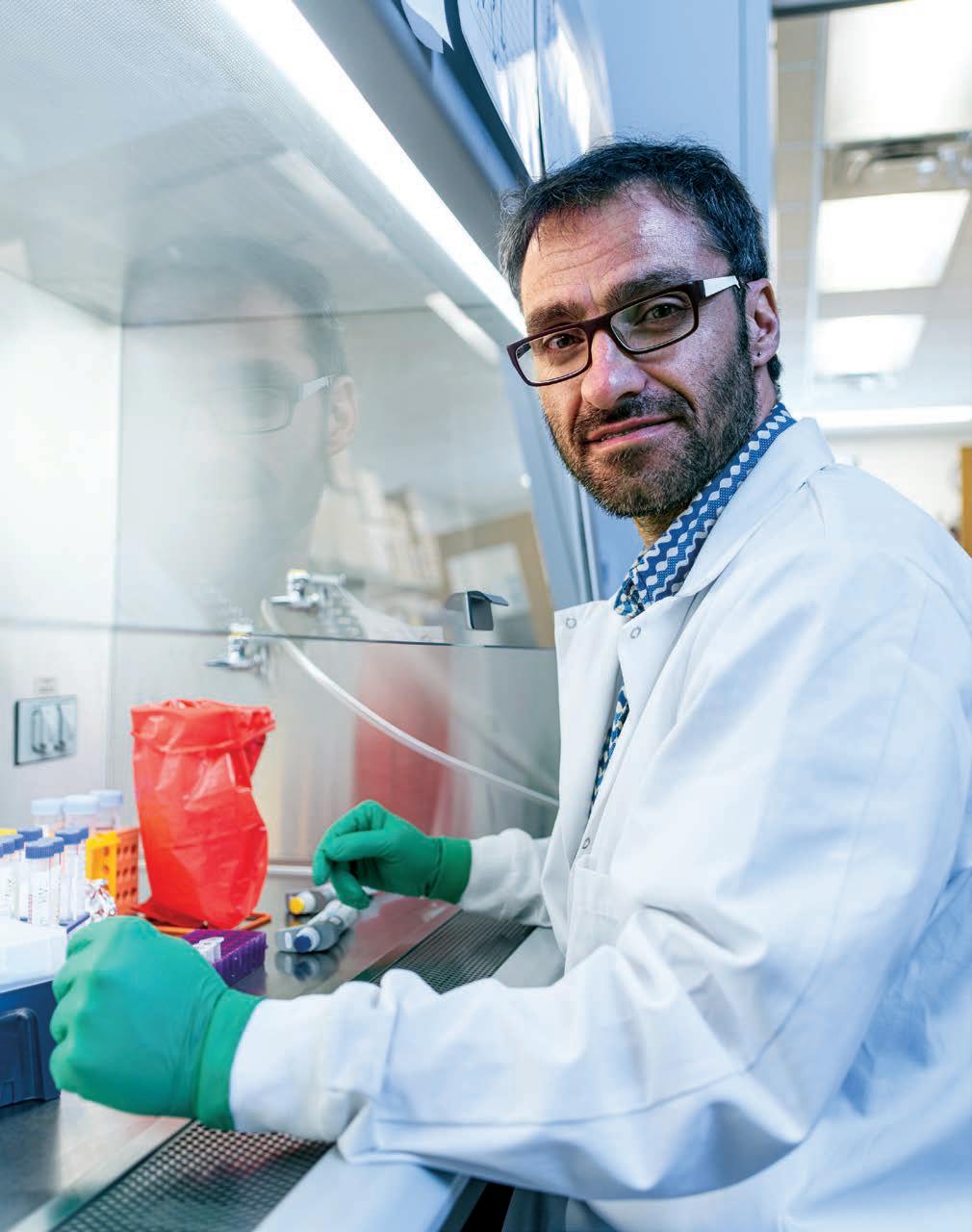
AN OVERNIGHT SUCCESS 20 YEARS IN THE MAKING
Ricardo Carrion, Jr., PhD, Professor, Director of High Containment Contract Research
In January of 2020, I was at a meeting in Washington, D.C., where the topic was this new emerging virus that could become a pandemic. Very early on, I started talking to my colleagues at Regeneron about a monoclonal antibody (MAb) they were developing for the treatment of COVID-19. We already had a relationship with them, because my lab conducted a lot of the research on their MAb treatment for Ebola. A key part of developing these treatments is testing them in non-human primates. For COVID-19, we
Ricardo Carrion, Jr., PhD
demonstrated that we could replicate disease in three different animal models: rhesus macaques, marmosets and baboons. We ended up using our rhesus macaque model to do some of the validation studies for Regeneron’s COVID-19 MAb treatment.
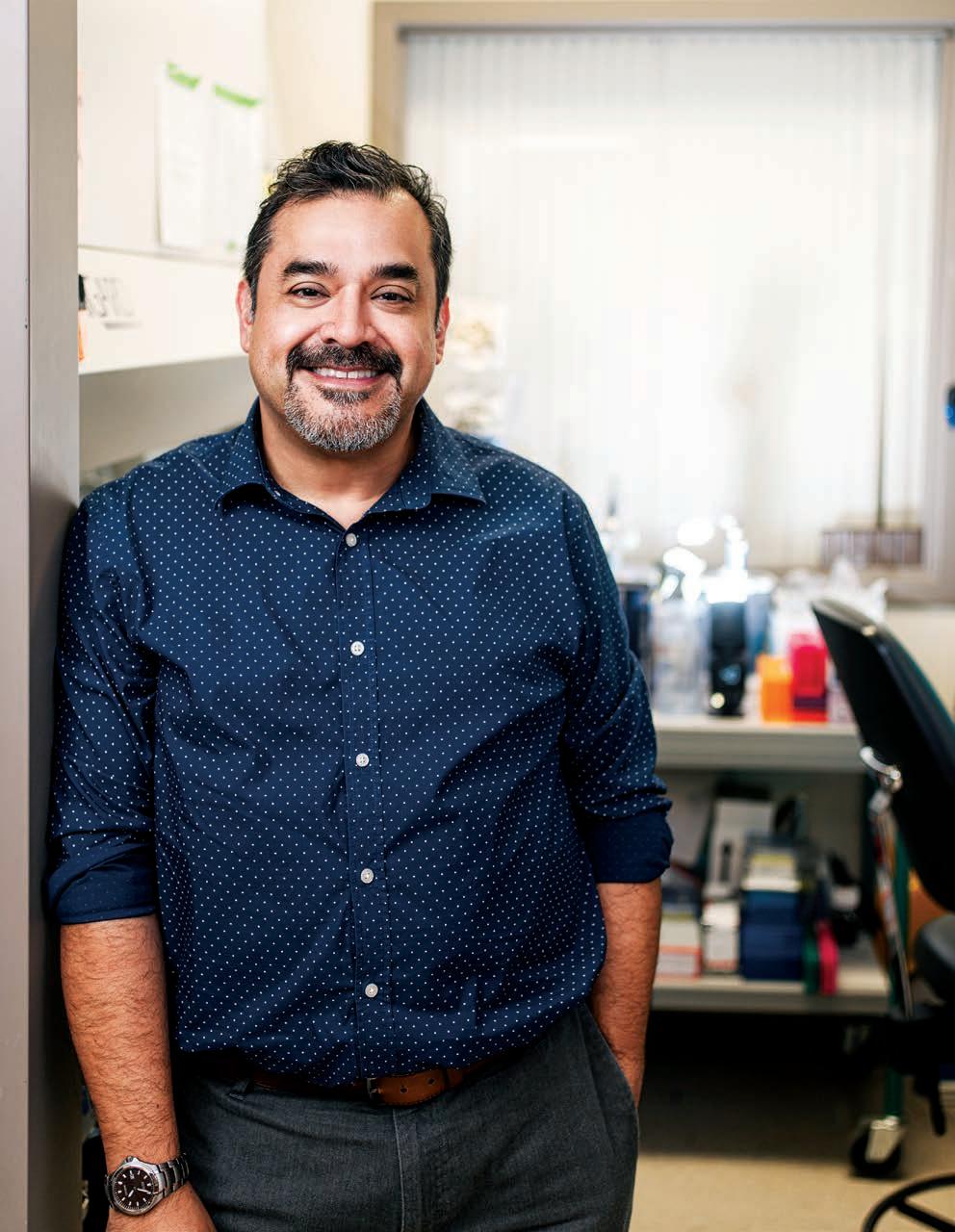
One reason we were able to respond to the pandemic so quickly and effectively is because of the past 20 years of experience we’ve had working with infectious agents. This includes not only Ebola virus but anthrax before that. We’ve been developing animal models as well as countermeasures such as vaccines and therapies against biosafety level (BSL)-4 infectious agents in advanced preclinical studies.
Anysha Ticer, Biocontainment Program Coordinator II
As a coordinator for these labs, I make sure that everything is calibrated and that the lab spaces have everything they need, including personal protective equipment (PPE) and other supplies. Of course with the pandemic, we were also hit hard with all of the demands for PPE as well as plastic pipette tips and syringes, and I’ve been very busy the past year because we’ve opened up new BSL-3 spaces on our campus.
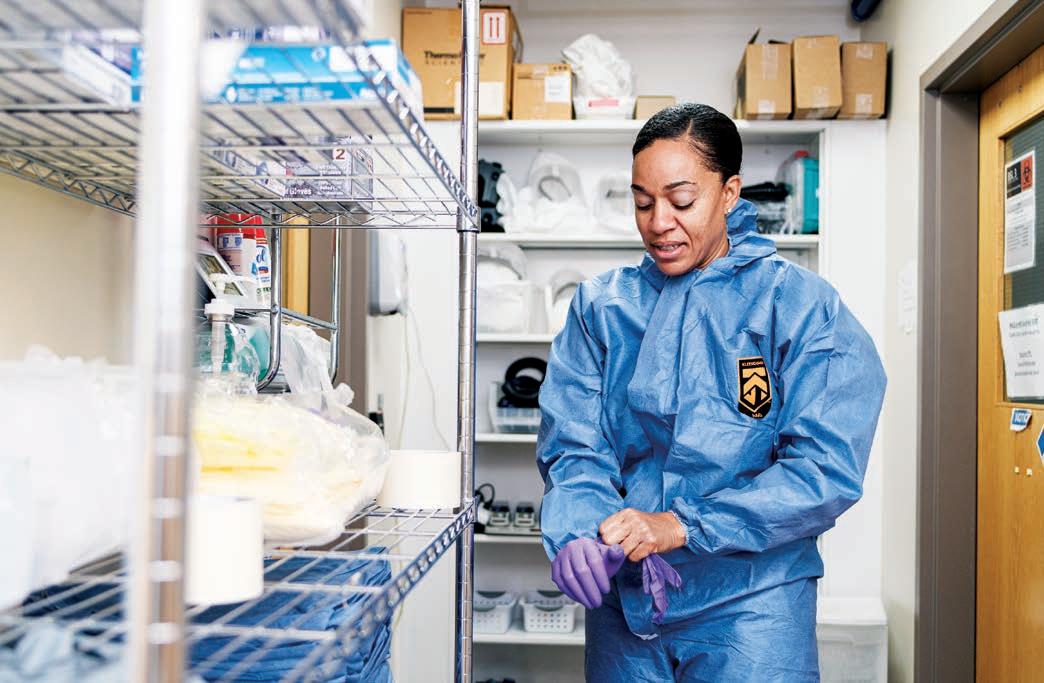
When COVID-19 first hit, we didn’t know what BSL level it was. We did some of the work in BSL-4 labs. We had to make sure we had enough respirator shrouds and protective suits for everyone. There are many people who use these spaces, including lab personnel and animal care staff.
Dr. Carrion: There have been shortages of certain reagents because of delays in the manufacturing pipeline. Fortunately, because we have been working on COVID-19 vaccines and treatments, that comes with a special designation from the United States government, which allows us to jump to the front of the line for any supplies that are needed for our SARS-CoV-2 research.
Because we are doing so much research right now, we’ve tried to keep three months’ worth of backup supplies for any type of experiment we might need to do. That way, if we encounter a situation where we can’t get a reagent, we’ll be able to finish the study we’re doing. There has been a downstream effect in our laboratories. We barely have room to walk because it’s crammed full of boxes of supplies.
We are continuing to do vital work. As variants of SARS-CoV-2 are emerging, we are doing more work in that area. We are looking at what the second generation of vaccines might look like — whether boosters might be needed, what they might look like, and how we can protect people against all the different strains of the virus.
Ms. Ticer: It’s really rewarding to play such an important role in this research. Everyone at Texas Biomed has had to work together. We’re all here for the same purpose. Because so many of us are considered essential staff, we never had a break away from campus. We had to keep the animal studies and all the other research going.
Everything happened at such a fast pace. We had to make sure that everything we needed to do was completely within the deadlines, while at the same time keeping all of our staff safe.
Anysha Ticer prepares for the BSL-3 lab.
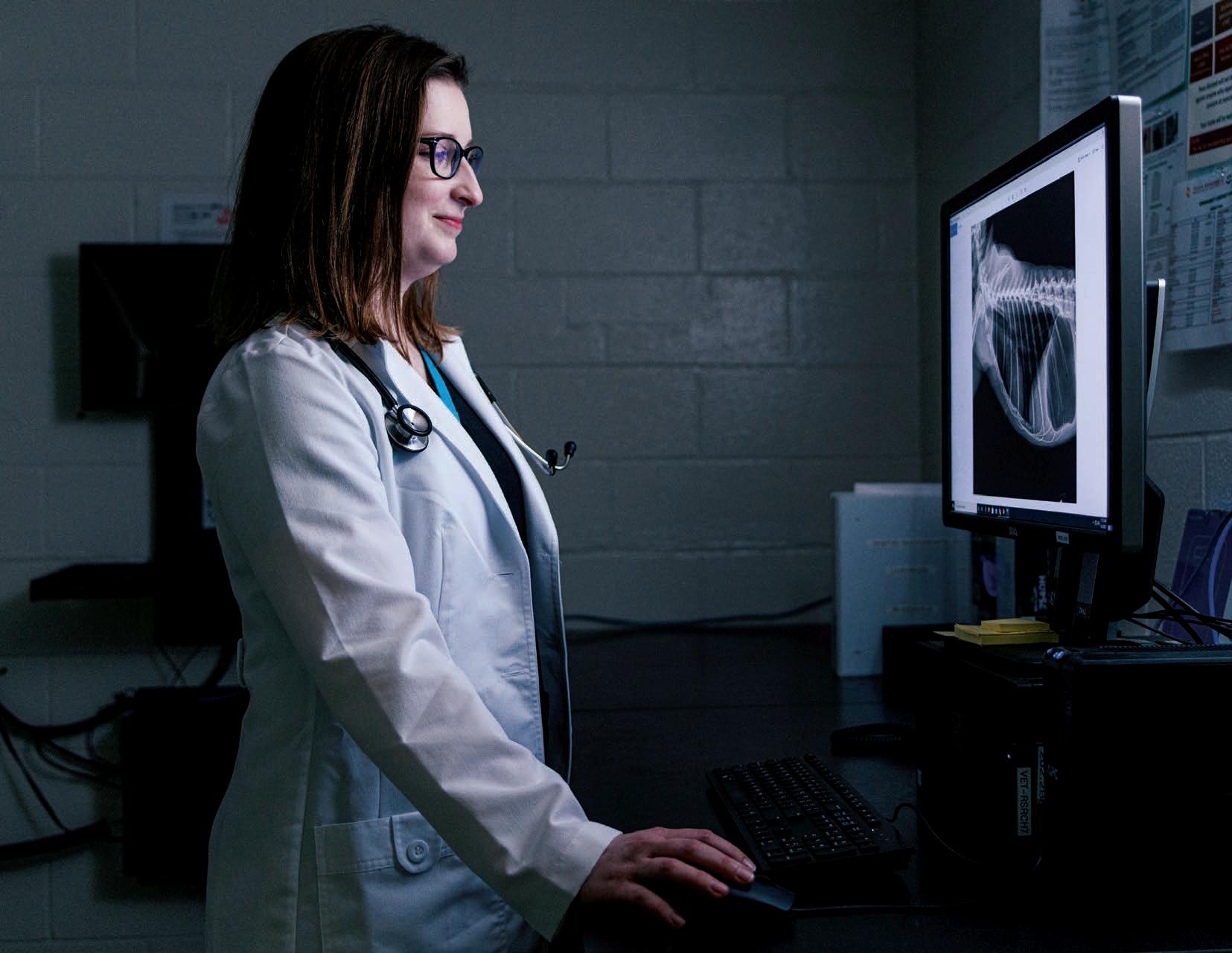
Elizabeth Clemmons, DVM
SPEEDING UP AS THE WORLD SLOWED DOWN
Elizabeth Clemmons, DVM, Assistant Professor, Veterinarian
The veterinarians at Texas Biomed provide clinical care for our animals on campus, but we also play a role in designing studies and developing new animal models. Before COVID-19, I was doing some work in the animal biosafety level (ABSL)-3 labs and also supporting the ABSL-4 lab’s work with Ebola and other hemorrhagic fever diseases. Thinking back to the beginning of the pandemic, the thing that stands out is how quickly everything moved. It was strange because outside of work everything was shutting down, but we were revving up and were busier than ever. I was in some of the initial planning meetings about SARS-CoV-2 research, when we were still having them face to face. And then we moved to very restricted interactions and virtual meetings, adding a new challenge to the work. For the first SARS-CoV-2 pilot studies, we needed to figure out what kind of nonhuman primate would be the best one to study the infection. We gave the virus to baboons, rhesus macaques and marmosets. It’s significant that we have such a variety of nonhuman primates at Texas Biomed, because most research centers would not be able to do this kind of work in multiple species. My main role was consulting with the veterinary radiologist. We were still learning what this disease would look like on X-rays and CT scans. There wasn’t an established way to evaluate the disease in nonhuman primates yet. The different species of nonhuman primates showed varying responses to disease. Additional studies have relied primarily on the macaques, partially because they are already a widely used model for infectious disease research. As the pandemic worsened, we had to be careful that our colony animals didn’t naturally catch SARS-CoV-2. We’ve done some testing of these populations and have a lot of safety measures in place to protect both people and animals.
The nonhuman primate models from Texas Biomed were essential to the preclinical work for Regeneron’s monoclonal antibody treatment and Pfizer-BioNTech’s vaccine, both of which were eventually approved for emergency authorization use. I was mainly involved in evaluating the antibody treatment, while other veterinarians on our staff worked more on the Pfizer-BioNTech study.
Veterinary technicians do the majority of the hands-on work, watching the animals for any clinical signs of infection and documenting what they see. We also collect swabs and other samples and regularly monitor the animals’ vital signs. We want to look at how the animals respond to the monoclonal antibody treatment or whether the vaccine protects them from infection.
The main focus for the year was our SARS-CoV-2 studies, but we were also extremely busy in the ABSL-4 lab, working on hemorrhagic fever projects. We’ve been refining models, including what is called a jacket and tether system. This allows us to draw blood or administer IV drugs through an indwelling catheter without handling an animal, so the monkey is sitting comfortably and doesn’t have to be sedated. This method has been used in biomedical research quite a bit, but we have applied some new strategies that are well suited to the unique challenges in high containment labs. It was a privilege to be involved in this work at such a weird and uncertain time in our lives. I’m proud to work here and be part of these projects.
ONBOARDING AND TRANSITIONING A RESEARCH PROGRAM DURING THE PANDEMIC
Luis Martinez-Sobrido, PhD, Professor of Disease Intervention & Prevention
I joined Texas Biomed in February 2020. It was a challenging time, both personally and professionally. As soon as I got here, everything shut down.
I was lucky enough to have everybody from my former lab at the University of Rochester come with me to Texas, so I didn’t have to recruit anybody during the pandemic. But, we didn’t have all of our biosafety and animal protocol approvals in place right away. There also was a shortage of reagents and other supplies that we needed in the lab. We were following the virus very closely since January 2020, before coming to Texas, and we already knew it would be an important concern for human health.
My lab usually studies influenza, Zika, Ebola, and arenaviruses, but because everything changed this year, we switched our research program from those other infectious viruses to studying only SARS-CoV-2. During this last year, we have published 20 manuscripts on SARS-CoV-2 and have around 10 currently under review. Our COVID-19 research has been focused on two major areas. One has been the development of animal models to study the virus. We have focused mainly on developing rodent models. One of them was a transgenic mouse model. This is a mouse that expresses the human receptor for the virus. This work has been in collaboration with Drs. Joanne Turner and Jordi B. Torrelles.
We also developed another rodent model, the golden Syrian hamster. Transgenic mice are great for studying some aspects of the pathogenesis of the virus, but they’re not a good model for transmission studies. That’s because mice don’t cough or sneeze. We knew that — like influenza — SARS-CoV-2 is mainly transmitted by aerosol. So the hamster model was important for research on preventing the spread and transmission of the virus. We thought that developing small animal models to study SARS-CoV-2 infection and COVID-19 disease would be helpful for validating or supporting conclusions before moving research into larger animals. The other thing we’ve invested a significant amount of time and effort since the pandemic started is developing reverse genetic approaches to generate recombinant SARS-CoV-2. We cloned the entire genome of SARS-CoV-2 into a plasmid, which is a small piece of DNA that can replicate independently in bacteria. The plasmid is then used to transfect cells and a few days later, you have SARS-CoV-2.
Reverse genetics is one of the most powerful tools in modern biology. We’ve been able to remove different proteins from the virus, in order to assess their contributions in viral pathogenesis. This technique also allows us to study the new variants of concern and variants of interest that have been emerging in different parts of the world and how the changes in these variants may contribute to SARS-CoV-2 pathogenesis.
We’ve also used these reverse genetics approaches to generate recombinant SARSCoV-2 that expresses fluorescent proteins. Now, when we infect cells with the virus, we can see where it goes. In animal models, this imaging allows us to see where the virus travels in the body. This is a technique that we had previously developed for studying other infectious viruses, and we brought this expertise and in vivo imaging with us to Texas Biomed. We thought it would be a great way to study SARS-CoV-2.
Since we published our research on reverse genetics and recombinant viruses in the middle of 2020, we’ve been contacted by close to 60 groups from around the world,
… WE’VE BEEN CONTACTED BY CLOSE TO 60 GROUPS FROM AROUND THE WORLD, ASKING US TO SHARE THIS TECHNOLOGY WITH THEM. WE THINK IT’S IMPORTANT TO DO THIS.
asking us to share this technology with them. We think it’s important to do this. It’s part of our obligation as good citizens to help fight the COVID-19 pandemic and contribute to other research to combat SARS-CoV-2. And, it helps put Texas Biomed out there, because everybody is now using our technology to generate recombinant SARS-CoV-2 and answer important questions in the biology of the virus, to identify new antivirals, and to develop new vaccines in our fight against COVID-19.
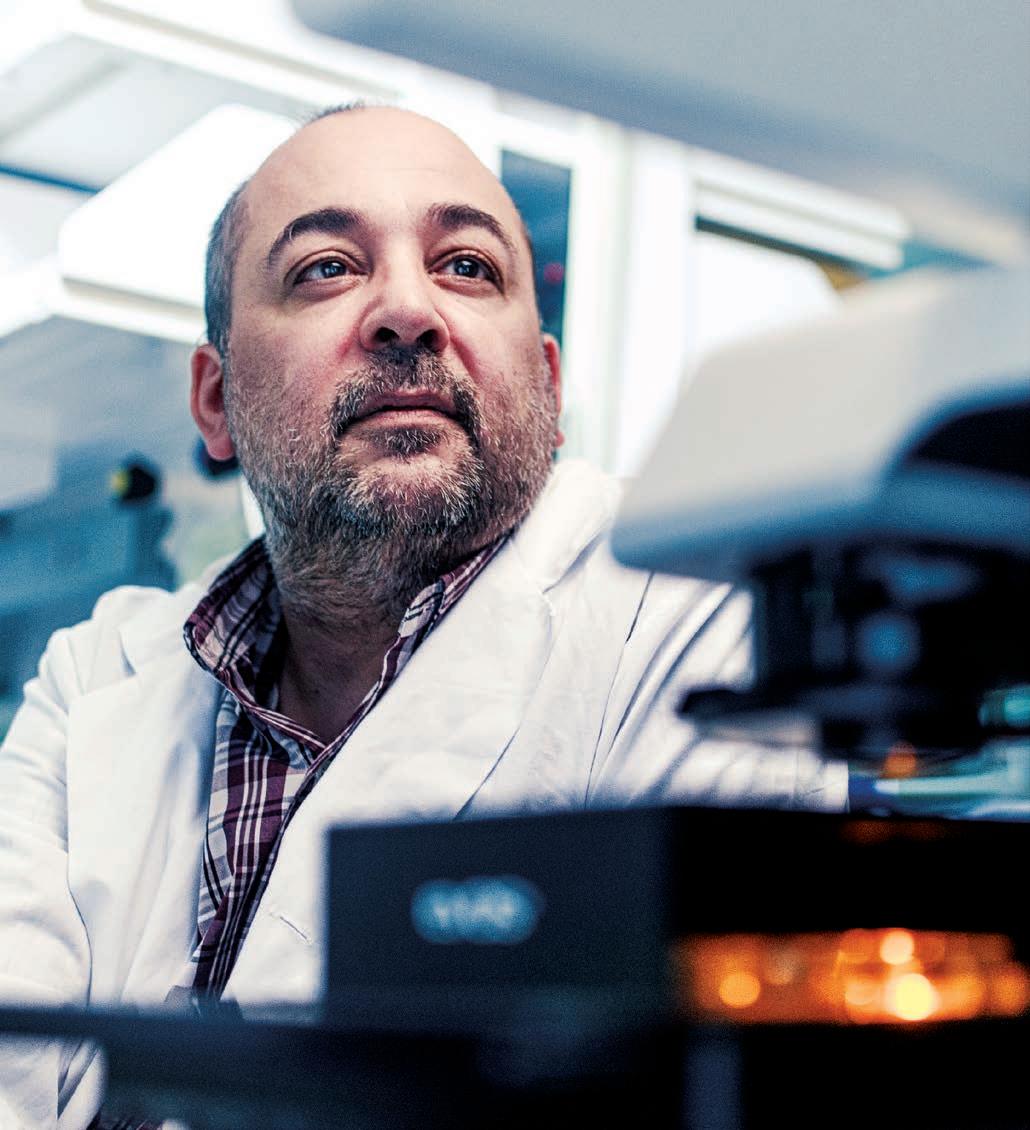
I want to recognize those in my lab who have contributed to this effort, including: Chengjin Ye, PhD; Jun-Gyu Park, PhD; Nidhi Kaushik, PhD; Desarey Morales Vasquez, graduate student; and Kevin Chiem, graduate student.
Luis Martinez-Sobrido, PhD
16
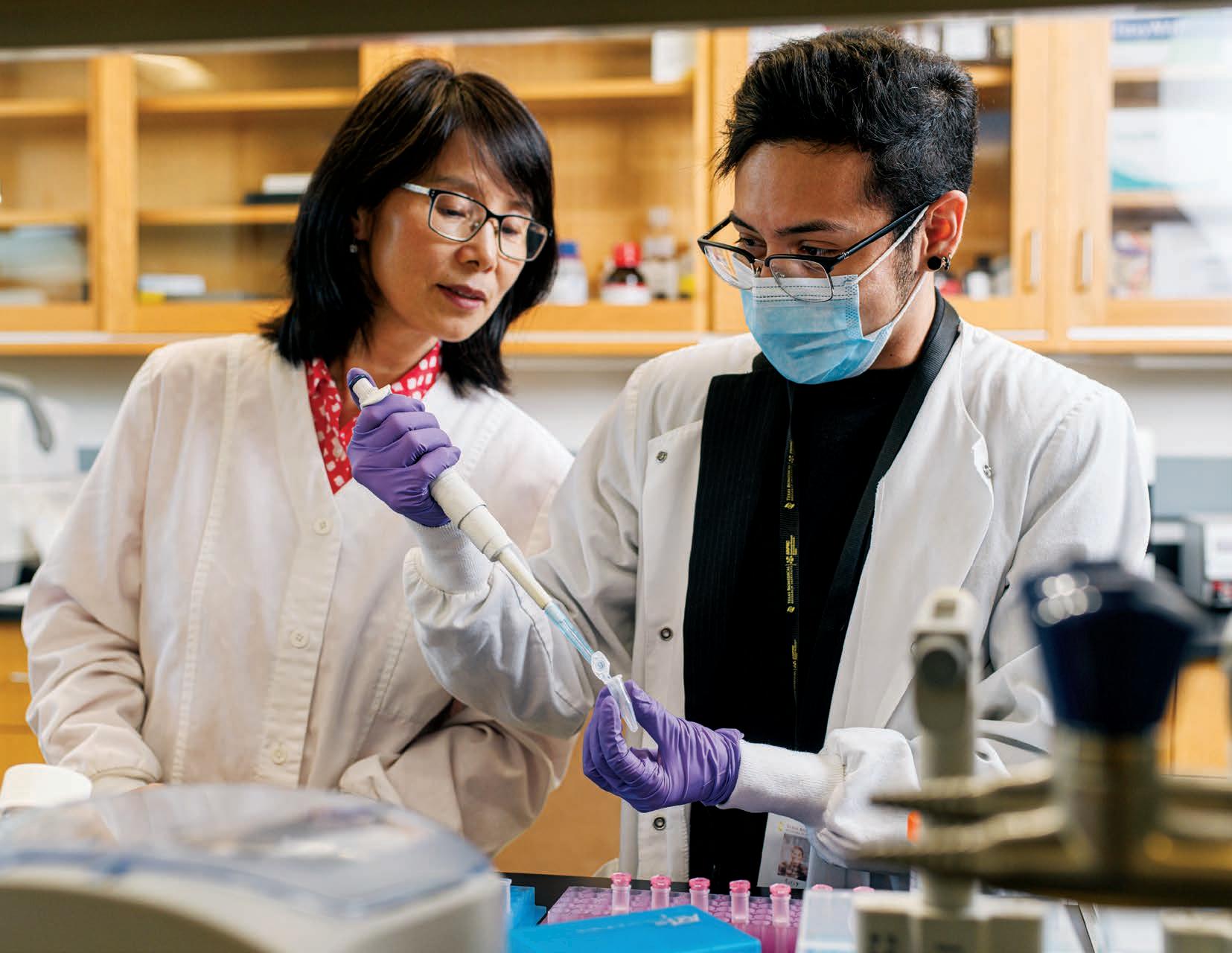
THE STAFF AND RESEARCH SUPPORT AT TEXAS BIOMED HAS BEEN AWESOME. WHEN WE GOT HERE THEY MADE SURE WE HAD THE SUPPLIES AND EQUIPMENT THAT WE NEEDED TO CONTINUE OUR RESEARCH. WE’RE VERY HAPPY TO BE HERE.
Binhua “Julie” Ling, MD, MMedSc, PhD and Grey De La Torre, Research Assistant
CONTINUING RESEARCH ON THE HIV PANDEMIC WHILE ANOTHER PANDEMIC RAGES
Binhua “Julie” Ling, MD, MMedSc, PhD, Associate Professor
I came to Texas Biomed in the summer of 2020, during the pandemic. I was already in the process of interviewing when the pandemic started. It’s been a challenging time. Nobody has ever run into this kind of situation before. We didn’t know how serious it would be and how long the pandemic would last. My work focuses on HIV and AIDS research, which is biosafety level (BSL)-2. So I haven’t been involved in the SARS-CoV-2 research, which requires a BSL-3 facility for cultures of the virus. But of course, we were affected by it. The members of my lab needed to social distance, and we needed to use all the protective and preventive methods to keep each other safe. In my research, I use the simian immunodeficiency virus (SIV). It’s like a brother or sister virus to HIV. When it infects non-human primates like rhesus macaques, they will develop a disease that is very similar to human AIDS if you don’t give them treatment.
For more than 10 years, I have focused my research on finding a cure for HIV. The current antiretroviral treatments that we have are very potent and can suppress the virus very well. When people take their prescriptions daily, they can live a relatively normal life. But the treatments we have now are not curative, and long-term daily treatment causes other health issues.
We know that HIV can hide in the body. Even when it’s undetectable in the blood, it may be hiding in cells and tissues, including in the gut and in the brain. I’m interested in studying the cell types where the virus can hide and finding out how we can get rid of it. Much of my current research has been funded by the National Institutes of Health to study virus persistence in the central nervous system.
When cells are infected with HIV (or SIV), the viral DNA gets inserted into the genome of the host cell. One thing we’ve done is use the CRISPR gene editing system to cut the viral DNA and remove it where it inserts into the genome of the host cell. In November 2020, we published a proof-of-concept study in Nature Communications that showed in SIV-infected macaques that the CRISPR gene editing system can remove the integrated viral DNA from infected blood cells and tissues with relatively high efficiency.
This research is ongoing. We’re now studying what happens if we treat animals with this gene editing technology and then remove their antiviral treatments. We’ll see if the virus comes back or not. This is critical to determine whether the virus has truly been removed, or whether you see a rebound where the infection comes back.
We also use barcoded viruses to try and track the source of the virus rebound and figure out where it hides. We use deep-sequencing technology to compare the virus from different parts of the body, lymph nodes, spleen, brain and other tissues, so that when the virus comes back, we detect where in the body it’s coming from. This gives us an idea of where we should focus when trying to eliminate residual virus, so that we can design a particular technology or method that’s focused on those types of cells in a particular tissue.
I have another project that’s focused on HIV and aging. The population that’s infected with HIV is shifting, and a good portion of the people who are infected are now over 50. Although antiviral treatments are very effective at controlling the virus, they do have side effects. Some studies have shown that they may play a role in accelerating the aging process.
Since our arrival, we have received incredible support from the staff and research operatives at Texas Biomed. They have made sure we had the supplies and equipment that we needed to continue and expand our research. We’re very happy to be here.








